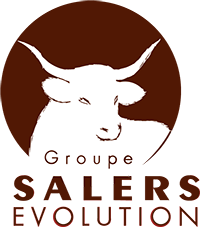tHE LEGEND
Several million years ago, the Good Lord sitting on his cloud in the company of St Peter contemplated the Cantal volcano. Thick tongues of lava spread out around an enormous crater which spat out fire and flames, sometimes throwing out arcs of red fireballs which ran down the steep flanks.
The Good Lord found this wonderful. St Peter said to him :
" - What a pity Lord ! when the volcano is extinct, what will remain of thy magnificent colors !
- You are right” replied the Most High."
Then, after reflection he declared : “From the red fireballs, I am going to make cows and they can wander at leisure in these mountains I will cover with rich grass.”
Later God created the Auvergnat and gave him this vast still-hot land.
A very remote and mysterious origin
The History of man in “the cradle” of the Salers breed indicates that the first known people of the region were a mixture of Celts and Iberians. The existence of this Iberian stain suggests a very early migration accompanied by cattle.
Thus several hypothesis have been put forward as to the origin of the Salers breed.
- In the South West of the Iberian Peninsula, Spanish “retintas” as well as “alentajana and algarvia” in Portugal have the same form of horn as Salers cows (for the females), and a similar coat color and pigmentation. Owing to the hot dry climate no doubt, the coat is tight in contrast to Salers. Some contemporary Spanish historians think that the branch came form Egypt via North Africa, Gibraltar and Spain, based on the evidence of Egyptian paintings and of the Tassili rock paintings in Africa.
- In Great Britain, the North Devon breed, although smaller due to the English selection preferences, has the same coat and colour and even the same head horn as Salers. Did Roman legionnaires take stock there from the Massif Central.
These hypotheses based on visual evidence tend to support the idea that Salers come from the Iberian peninsula to France then to the British Isles. Some Latin authors situate the second migration at the epoch of the Roman conquest. In any event, the breed is very old and Pliny the Elder (23AD) speaks in his writings of rounds of cheese brought to Rome by legionnaires. Doesn’t one say that the Salers are a breed from the fringes of our time.
However modern DNA research (Dan Bradley) strongly supports the view that Salers arrived by a Northern Danubian route during the Neolithic epoch following domestication, some 10, 000 years ago (in present day Turkey) (Cymbron et al Proc. R Soc B (2005) 272, 1837-1843).
Evolution
The development of the breed …
The beginning of genetic improvement
The middle of the 19th century was a “grand epoch” for the improvement of French breeds. English type selection appeared and there was a vast exchange of ideas between forward-looking breeders.
Two schools of thought can be distinguished.
The Farm school of Saint Angeau (Cantal) tried crossing with Devon, Durham and Highland cattle but the crosses died from pulmonary TB. There remains some popular belief that Durhams (Shorthorns) had some influence. However modern DNA analysis (Grosclaude) shows the influence is minimal and there is 400 times more Shorthorn blood in Charollais than Salers for example.
Around 1850, Tyssandier d’Escous effectively founded the Salers breed. Fierce opponent of the contribution of other breeds in improvement, he believed in selection by mating between the best available and improving nutrition. This was put into practice in some domains in the region of Salers (a village in the Cantal). Continually recruiting new followers to his methods, he succeeded very quickly in gaining a good reputation for animals from Salers. He also ensured that the name of the breed as “Salers” succeeded that of the “Auvergne breed”.
It was also he who initiated the first departemental Salers show on the 17th of August 1853 in Salers village. The Salers Herd Book was created in 1906. At this time the Salers was not the only breed to promote itself and to present good quality animals. The first breed standards (or descriptions) were defined and they are still pertinent.
The first scoring systems appeared in 1925. They were used for registration of the animals. At this epoch, Salers were a mixed breed, producing milk and beef as well as being draft animals.
…before a phase of decline
The 60’s saw the arrival of mechanisation but also and above all the arrival of specialist milk breeds. Salers were overtaken and the local cheese production saw a decline in prices. In addition, the traditional system (in which the presence of a calf to trigger let down is needed) is too labour-intensive. It thus found less and less willing farmers.
In this context, the Salers breed owed its survival to the production of weanlings for Italy, a keen market for this type of animals. There was also demand in Eastern France. In addition, beef production from 18-24 months bulls made the appearance and was more profitable than steer beef. In the 1970’s, Salers as with other breeds did not escape brucellosis. The number of holdings in the Cantal were affected and this held up the expansion of breed particularly to Eastern France.
There is currently a strong national development !
Salers spread widely from the west of the Cantal to the nearby Departments of the Haute-Loire, the Puy-de-Dôme, the Corrèze, the Lot and the Aveyron. Thus the heartland is principally in the old province of Auvergne which covers many of these newer Departements. Nevertheless the maternal and the commercial qualities of Salers were known outside the heartland. The interest of the breed crossed the frontiers and Salers are now present in 90 Departments of France and in 30 countries in 5 continents.




